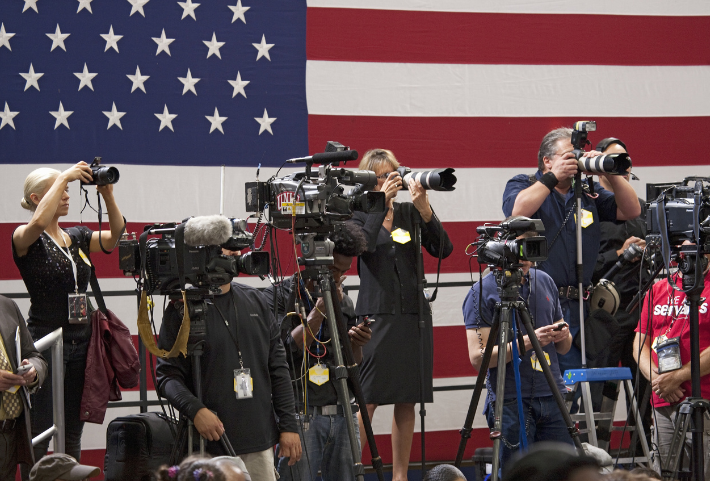By Rob Leavitt, MDI US Board Director
New York City University journalism professor and critic Jay Rosen struck a nerve within many US news organisations in March of 2023 when he tweeted six words of guidance for reporting on the 2024 elections: “Not the odds, but the stakes.”

As he went on to explain: “That’s my shorthand for the organising principle we most need in journalists covering the 2024 campaign. Not who has what chances of winning, but the consequences for American democracy. Not the odds, but the stakes.”
It’s hard to argue with Rosen, especially in an election year when the stakes seem so high vis a vis fundamental issues such as democracy and civil rights in the US, the role of the US in the world, wars in Ukraine and the Middle East, climate change, immigration, and more.
Indeed, the stakes seemed to become even higher in the aftermath of President Biden’s disastrous performance in a televised debate with Donald Trump on June 27th and the subsequent calls for Biden to drop out of the race.
But Rosen’s focus is primarily on what is commonly called “mainstream media” – The New York Times, CNN, National Public Radio, and other news organisations that, even if they lean liberal, remain committed to the core tenets of independent journalism and accurate reporting.
The primacy of “horse race journalism” has long been a focal point for critiques of mainstream political reporting in the US. Equipped with a seemingly endless supply of public opinion polls and reinforced by a seemingly endless supply of political consultants and pundits anxious to demonstrate their political IQ, news organisations have leaned heavily for decades on coverage of who’s ahead and why, the merits of different campaign strategies, and all manner of “behind the scenes” description and analysis.
Horce race journalism and the impact on diversity and inclusion
From the perspective of inclusive journalism, the horse race focus has tended to crowd out significant attention to the issues, concerns, and perspectives of the incredibly diverse communities and groups that make up the American electorate.
It’s not difficult to imagine what a more inclusive approach might look like: Deeper and more diverse types of stories, documentation, and data about the lived experience of different groups; nuanced viewpoints from diverse community representatives on the issues that matter most to them; and, of course, diverse and inclusive newsrooms.
Indeed, powerful examples of this type of coverage do appear regularly across the media writ large. Check out the latest Pulitzer Prizes in journalism, for example. You’ll see investigative reporting on secret gifts to Supreme Court justices, local coverage of the catastrophic impact of flooding and mudslides on Santa Cruz, California, deep reporting on the reach of migrant child labour across the US, feature writing on one family’s struggle during a matriarch’s slide into dementia, and a powerful audio series revisiting a Chicago hate crime from the 1990s, to name just a few of the winners.
Leading mainstream news organisations have also provided strong reporting on “the stakes” in 2024 with detailed coverage, for example, of Project 2025, a wide-ranging planning process supported by dozens of influential conservative organisations to help a next Trump Administration move aggressively to remake federal institutions, dramatically increase presidential power, and, in their own words, “rescue the country from the grip of the radical Left”.
But this type of reporting tends to be episodic, at best, across individual media outlets – and almost nonexistent across the majority of news organisations that continue to downsize, prioritise clicks over context, and generally struggle to survive.
Election coverage
For election coverage in particular, the continued focus on “the odds” often reduces the richly diverse communities and groups across America into crudely defined targets of opportunities for campaign strategy and outreach: How can Democrats more effectively mobilise pro-choice suburban mothers in the wake of anti-abortion rulings and legislation? How likely is it that Trump can take another 10% of the vote from Hispanic males 18-35 without a college degree?
News coverage of the campaign following the debate has demonstrated clearly the dominance of the horse race approach. We have seen seemingly endless reporting on post-debate polling, “inside” stories on the odds of Biden dropping out, and far less reporting on the substance of the candidates’ positions, the blatant racism from Trump throughout the debate, or the impact of multiple extremist decisions from the US Supreme Court that same week.
All of this is only part of the election reporting story, however. The decline of independent local news organisations, the rise of clearly partisan (largely conservative) media, the explosion of social media, and the proliferation of deliberate and aggressive mis- and disinformation from local, national, and international organisations means that vast swaths of the public pay little attention to any of the forementioned election reporting at all.
Indeed, a new report from NewsGuard, a misinformation tracking company, has identified at least 1,265 “pink slime” websites funded by political donors (mostly but not entirely conservative) and masquerading as local news sites. This outnumbers the 1,213 daily local newspapers that remained last year (and many of those have since closed down). Meanwhile, an aggressive public campaign from conservative politicians, media, and influencers (most prominently including Elon Musk) has attacked independent efforts to expose or counter deliberate mis- and disinformation.
Ironically, a great deal of conservative media harps incessantly on “the stakes” of the 2024 elections but with wildly exaggerated and often demonstrably false stories and themes: The radical socialist left is destroying the country, engineering “the great replacement” of “real Americans” with waves of illegal immigration, destroying Christianity, etc. – all, of course, after “stealing” the 2020 election from Trump.
The power of “alternative facts” means that majorities of conservative voters believe that Biden was not legitimately elected in 2020 (he was), that crime is dramatically rising (it is not), that the US economy is a disaster (it’s doing better than most other developed nations), and that minority groups are destroying “our” way of life (they are not!).
Fortunately, if you’re trying to track all this from home, the US has numerous professional media research and analysis organisations that are dedicating substantial resources to ongoing review of the good, the bad, and the ugly of election reporting.

General coverage of election reporting:
- Poynter Institute
- Neiman Lab
- Media Matters for America
- Media Insight Project (focus on news consumers)
Coverage of inclusive reporting:
- Maynard Institute
- National Association of Black Journalists
- National Association of Hispanic Journalists
- Asian America Journalists Association
- Indigenous Journalists Association
- The Association of LGBTQ+ Journalists
Pictures from shutterstock.com
Disclaimer:
The views and opinions expressed in this article are solely those of the author and do not reflect the official policy or position of the Media Diversity Institute. Any question or comment should be addressed to [email protected]
